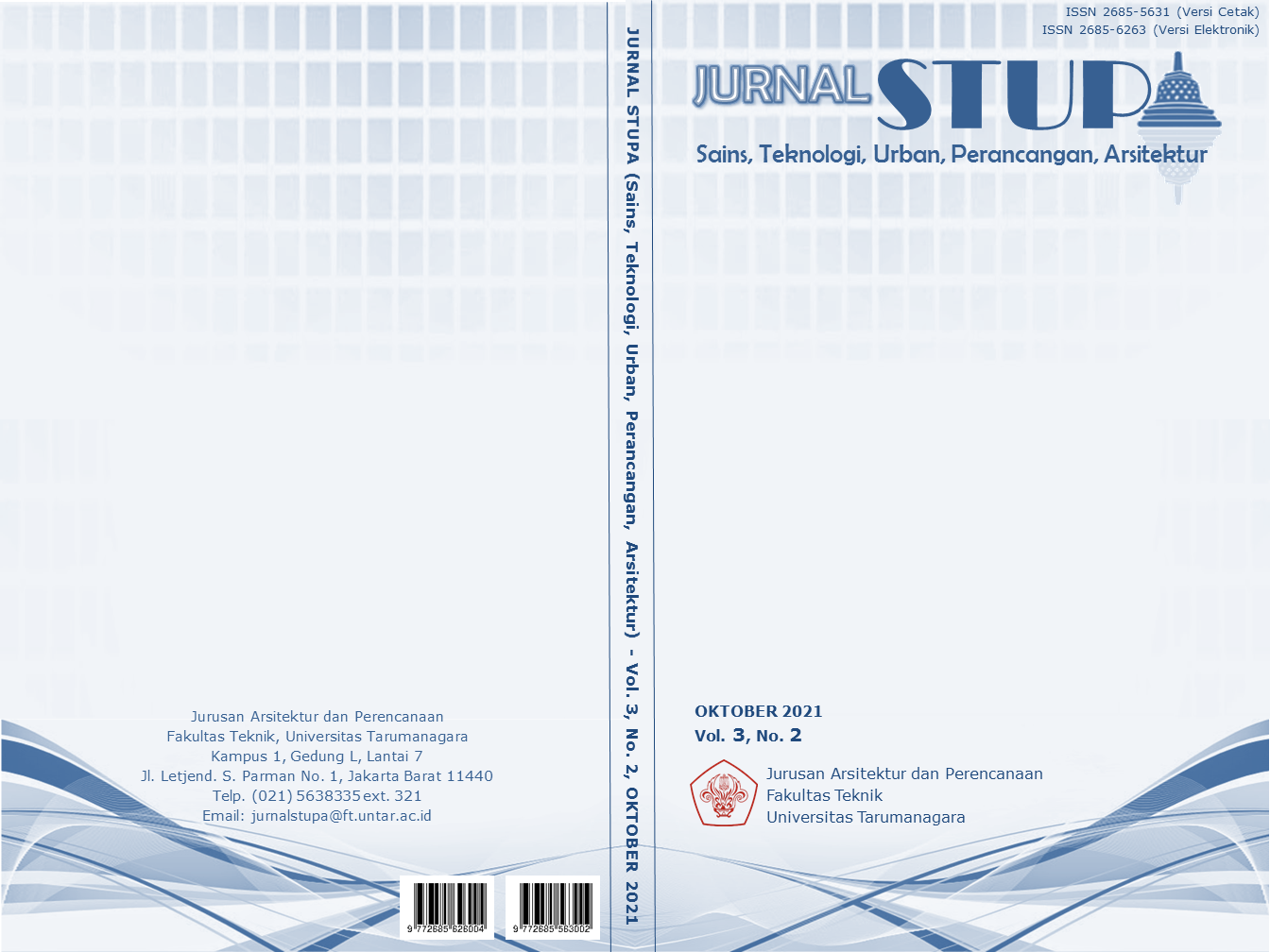PENERAPAN SELF-SUFFICIENT PADA REDESAIN RUMAH SUSUN KEBON KACANG
Main Article Content
Abstract
House is the safest place to avoid Covid-19. The lives of people who live in landed houses and flats are different. People's lives have changed drastically from all aspects, namely health, economic, social, and other aspects. This Covid-19 condition requires people to stop doing normal activities temporarily. This condition can be done by redesigning old flats as a solution, such as the Kebon Kacang flats. In addition to being old, this flat is also getting shabby, not to mention its strategic location in the middle of a city that should have potential. Kebon Kacang flats project aims explicitly at the residents of the flats by offering facilities to fulfill their daily activities and needs to avoid Covid-19. In addition, redesign tends to play an essential role in the environment, such as providing needs for residents so that they do not need to travel. These also impact ecology, such as increased air quality due to the reduced use of motorized vehicles. Using analytical descriptive research methods, literature studies and case studies, and the self-sufficient design methods approach aims to make the building and occupants mutually productive and create a new sufficient habit due to this pandemic. Self-sufficient application in this project involves rainwater harvesting, food production, green roof, and green balcony. The redesign of the Kebon Kacang flats offers residential, commercial programs such as food markets, food courts, cafes/coffee shops and kiosks, education for children, facilities such as hydroponics, gyms, playgrounds, and others.
Keywords: Covid-19; flats; house; redesign; self-sufficient
Abstrak
Rumah menjadi tempat yang paling aman untuk menghindari Covid-19, tetapi perbedaan kehidupan masyarakat yang tinggal di rumah tapak dengan rumah susun sangatlah berbeda. Kehidupan masyarakat yang berubah drastis dari segala aspek, yakni aspek kesehatan, ekonomi, sosial, dan lainnya. Dimana kondisi Covid-19 ini mengharuskan masyarakat untuk secara temporari menghentikan aktivitas normal sampai tidak tahu lamanya. Hal ini dapat dilakukan dengan cara meredesain rumah susun yang sudah berusia tua, misalnya rusun Kebon Kacang. Selain umur bangunan sudah tua, rusun ini juga sudah semakin kumuh, belum lagi letaknya yang strategis di tengah-tengah kota yang seharusnya dapat menjadi potensi. Dengan membangun proyek redesain rumah susun Kebon Kacang khususnya ditujukan untuk penghuni rumah susun dengan menawarkan fasilitas-fasilitas untuk memenuhi aktivitas dan kebutuhan sehari-hari mereka, serta sistem untuk menghindari Covid-19. Selain itu dengan redesain cenderung berperan penting terhadap lingkungan, selain menyediakan kebutuhan untuk penghuni sehingga tidak perlu melakukan perjalanan, ini juga berdampak terhadap ekologi, seperti kualitas udara yang meningkat akibat berkurangnya penggunaan kendaraan bermotor. Dengan menggunakan metode penelitian deskriptif analisis, studi literatur dan studi kasus, dan metode perancangan self-sufficient yang bertujuan agar bangunan dan penghuni dapat saling produktif serta mengubah kebiasaan penghuni menjadi lebih mandiri terkait pandemik Covid-19. Penerapan self-sufficient pada proyek meliputi rainwater harvesting, food production, green roof, serta green balcony. Pada redesain rumah susun kebon kacang ini menawarkan program hunian, komersial seperti food market, foodcourt, café/coffee shop dan kios, pendidikan untuk anak, fasilitas-fasilitas seperti hidroponik, gym, taman bermain, dan lainnya.
Article Details
References
Bariah, C. (2020, Maret 21). Pengaruh Corona Terhadap Kehidupan Sosial Masyarakat. Retrieved Mei 31, 2021, from Serambinews.com: https://pengaruh-corona-terhadap-kehidupan-sosial-masyarakat?page=all
Brooks, S. K., Webster, R. K., Smith, L. E., Woodland, L., Wessely, S., Greenberg, N., & Rubin, G. J. (2020). The Psychological Impact of Quarantine and How to Reduce it: Rapid Review of the Evidence. The Lancet, 395(10227), 912-920. doi:10.1016/S0140-6736(20)30460-8
Carmona, M., Tiesdell, S., Heath, T., & Oc, T. (2003). Public Spaces - Urban Spaces, the Dimension of Urban Design. Oxford: Architectural Press.
Creswell, J. W. (2013). Qualitative Inquiry & Research Design: Choosing Among the Five Approaches. Thousands Oaks, CA: Sage Publications, Inc.
de Garrido, L. (2012). Self Sufficient Green Architecture. Barcelona: Instituto Monsa de Ediciones, S.A.
Haeckel, E. (1866). Generelle Morphologie der Organismen. Allgemeine Grundzüge der Organischen Formen-Wissenschaft, Mechanisch Begründet Durch die von Charles Darwin Reformirte Descendenztheorie. Berlin: Georg Reimer. doi:https://doi.org/10.5962/bhl.title.3953
Huang, C. W. (2020). Clinical features of patients infected with 2019 novel coronavirus in Wuhan, China. The Lancet, 395(10223), 497-506. doi:10.1016/S0140-6736(20)30183-5
Ichwan, L. A. (2010, Desember). Retrieved Juni 6, 2021, from Pergeseran Fungsi Ruang Publik Selasar Pada Rumah Susun: http://lib.ui.ac.id/file?file=digital/2016-8/20249595-S51560-Luthfi%20Abdillah%20Ichwan.pdf
Perhimpunan Dokter Paru Indonesia. (2020). Panduan Praktik Klinis: Pneumonia 2019-nCoV. Jakarta: Perhimpunan Dokter Paru Indonesia. Retrieved from http://www.rsi-ibnusina.com/media/file/corona.pdf
Porta, M. (2008). Dictionary of Epidemiology. Oxford University Press.
Roidah, I. (2014). Pemanfaatan Lahan Dengan Menggunakan Sistem Hidroponik. Jurnal Universitas Tulungagung Bonorowo.
Shang, Y. C. (2009). The Autonomous House: A Bio-Hydrogen Based Energy Self Sufficient Approach. International Journal of Environmental Research and Public Health.
Susilawati, Falefi, R., & Purwoko, A. (2020). Impact of Covid-19's Pandemic on the Economy of Indonesia. Budapest International Research and Critics Institue (BIRCI-Journal): Humanities, 3(2), 1147-1149. doi:10.33258/birci.v3i2.954
Wang, Z., Qiang, W., & Ke, H. (2020). A Handbook of 2019-nCoV Pneumonia Control and Prevention. China: Hubei Science and Technology Press. Retrieved from http://fpmpam.org/files/Handbook_2019nCoV.pdf
WHO. (2020, Februari 11). WHO Director-General's remarks at the media briefing on 2019-nCoV. Retrieved Juni 30, 2021, from World Health Organization: https://www.who.intl/dg/speeches/detail/who-director-generals-remarks-at-the-media-briefing-on-2019-ncov-on-11-february- 2020



